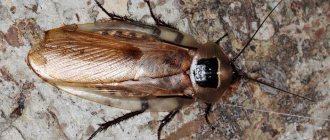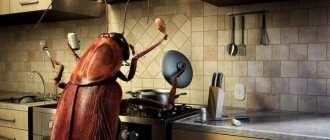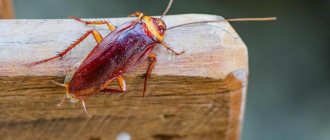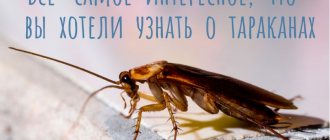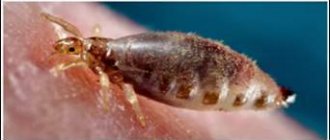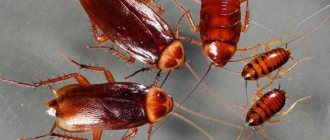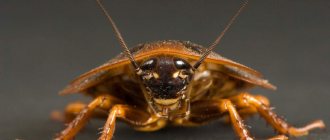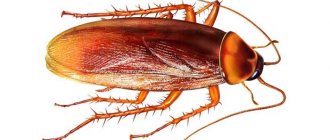Insects 08/06/202010837 views
Madagascar hissing cockroaches are a genus of cockroaches found exclusively in Madagascar. There are about 20 known species of hissing cockroaches; there are very big problems with the taxonomy of most, since it is not clear whether they are a whole species with variations in colors, or different species.
The most striking difference from most cockroaches is the absence of wings at all stages of development. Having excluded the ability to fly, nature gave these cockroaches a durable chitinous shell, as well as a characteristic shield on the cephalothorax, on which males grow horns. And, of course, do not forget about the size - some species can reach nine centimeters. The color of these insects varies from light red to almost black. As a rule, their nymphs are darker than adults and have a more dense build. It is quite easy to distinguish between males and females in most cases. Males, as mentioned earlier, have horns, which are the main difference. But some species lack these horns, making sex determination more difficult. Then you can focus on the last segments of the abdomen; in females they are wider than in males.
A cozy home for your pet
For Madagascar cockroaches, a plastic aquarium at home is suitable as a home.
Its volume is determined from the following standards - one liter of space per individual. The presence of handles and light weight will allow the owner to take the insectarium with him. For example, to participate in exhibitions or organize long-distance moves. The presence of ventilation holes allows you to keep adult individuals or young animals older than four months in such aquariums. Cockroaches that have just been born can be kept in ordinary jars with a volume of three to five liters. The lid will be gauze secured to the neck with an elastic band.
Drinking bowl
Cockroaches from Madagascar require constant access to water. Just don’t just put a container of water in the terrarium (like the one given to decorative rabbits) - the insects will simply drown in it, especially if there are a lot of young animals in the colony. The best solution to this problem would be a special drinking bowl, which can be easily done at home. Take a small piece of material similar to a sponge or foam rubber, place it in a shallow container and regularly moisten it with water.
Specific features, characteristic only of this type of cockroach, make it possible to distinguish it from a wide range of relatives and attract human attention. For example, a female insect is viviparous, that is, she does not lay eggs (which is what the inhabitants of average kitchens do). The emerging larvae spread throughout the terrarium at an impressive speed.
It will take them about four months to achieve external resemblance to their parents. One clutch contains from 10 to 50 larvae
The hatching larvae spread throughout the terrarium at an impressive speed. It will take them about four months to achieve external resemblance to their parents. One clutch contains from 10 to 50 larvae.
Litter
To create comfortable conditions, it is recommended to cover the bottom of the container:
- sawdust,
- shredded sheets of clean writing paper,
- coconut substrate,
- clay mixed with sand,
- small pebbles.
Small pressed sawdust, which is often used for cat litter, is also suitable. What layer height to choose is a matter of personal preference of the owner. The same applies to the presence or absence of bedding, since it does not have any effect on the health of the cockroach.
If the owner decides that his Madagascar cockroach needs bedding, he should remember not to use sawdust from coniferous trees, especially if it is cedar. The frequency of substrate change is determined by the number of individuals and cell size. As a rule, the average is once a month.
Individual "houses"
Endemic to the island of Madagascar, they are nocturnal by nature. In their homeland during the day they hide under stones and leaves. At home, cylinders that are hollow inside will serve as shelter, which can be connected to each other to form various structures. Egg cages can also be an option – breeders often use them to build small houses that increase the usable area of the cage.
Pieces of pine bark, as well as clay figurines intended for fish, provide excellent shelter.
Temperature and humidity
Comfortable temperature indicators are 25-30°C. Lower numbers make cockroaches passive and reduce the likelihood of having offspring. Humidity is also of great importance - about 65%. Spraying the walls of the terrarium with plain water several times a week helps maintain it. A regular sprayer is suitable for these purposes.
Distribution area
The American cockroach is widespread in its homeland - Africa and the countries of North and South America. Recently, it has become increasingly noticed in Europe, but in Russia it has been replaced by the Prussian, which is more adapted to life in urban conditions. In this regard, the large size and large number of offspring played a bad joke on the American immigrant.
In order to feed numerous voracious offspring, you will need supplies larger than those stored in an ordinary typical apartment, and the harsh climate of mid-latitudes does not allow you to settle in garbage cans, always full of food. And it’s much more difficult for a big American to hide than for a Prussian midget.
As a rule, insects of this species inhabit large heated industrial buildings with an extensive ventilation system, sewers, and food plants. In their homeland, they settle not far from human habitation, feeding on the remains of civilization waste.
What affects the rate of reproduction and appearance of eggs and nymphs
The key factor that allows larvae to hatch from the ooteca is air temperature. The duration of embryo development directly depends on this parameter: when it gets cold, the formation of the offspring of these pests is inhibited, and when there is strong warming, on the contrary, it accelerates. In addition, the air must be sufficiently humid. It is known that when the moisture content drops below 40%, the ootheca dries out. In addition, the rate of development of the offspring inside the eggs is determined by their belonging to a particular species.
In warm areas of the apartment, cockroaches will breed quickly enough
Mating process
Reproduction of Madagascar cockroaches begins in the spring. Males hiss and whistle to attract a female. If several males claim a female, then battles between rivals occur.
They push with their bellies, trying to push the enemy as far as possible. Cockroaches fight with projections on the head shield and bite off each other's antennae. The winner gets the female.
It is recommended to place coconut substrate in a container with a pregnant female. It retains moisture well. Under comfortable conditions, cubs appear 55 days after mating and fertilization.
If the microclimate in the terrarium does not correspond to the norm, then the development of embryos is delayed. Pregnancy can last up to 77 days.
When the young are fully developed, they gnaw through the ootheca. The female Madagascar cockroach opens the genital slit in the abdomen and releases the young. She tenses her abdominal muscles, pushing out the babies.
Appearance of insects
Cuban cockroaches belong to the Blaberidae family of large tropical cockroaches, genus Blaberus. They are the most common insects kept in home terrariums and raised as food for reptiles and spiders. Adults are impressive in size. Body length is 60-80 mm. The body is flat, the black head is covered with a light straw pronotum. The elytra are dense, the wings are cream with a transverse brown stripe. The antennae are elongated, the mouthparts are of a gnawing type.
The larvae are similar to the extinct marine arthropod trilobites. Their shell is covered with longitudinal grooves. As it moves along the forest floor, lumps of earth, leaves and other objects stick to it. They become a camouflage for a small insect. This allows him to remain undetected by predators. The larvae love to burrow into the litter. Adults are active in the evening and at night. They climb trees and easily fly from branch to branch. They feed mainly on fallen leaves and fruits, sometimes eating dead animals. In nature, cockroaches live for about a year, in captivity - 1.5-2 years.
Platypus
The platypus (Ornithorhynchus anatinus) lives in streams, ponds and rivers in Australia. These animals usually reach a length of 30–40 centimeters and weigh about 2 kilograms.
The unusual thing about the platypus is that it combines the features of mammals, birds, reptiles and even fish. Looking at it, you won’t immediately understand whether it’s a bird or some kind of animal... In fact, these creatures are mammals, although they lay eggs. The platypus is a bit like a beaver, but with a soft beak covered with elastic skin, which is not found in any other animal. Underwater, the platypus closes its eyes and uses its beak, with which it senses weak electrical impulses emanating from its prey. Using its beak, the platypus digs through the mud in search of small fish, frogs and insects. Scientists are still arguing about the origin of this species, but only one thing is clear - this is a unique creation of Mother Nature, which differs from all other species currently living on planet Earth.
Male platypuses have poisonous spurs on their hind legs. The animal's venom is unlikely to kill a person, but it causes severe pain at the injection site. But for small animals this poison is often fatal.
Distinctive appearance features
The Madagascar hissing cockroaches include a whole group of cockroaches whose habitat is Madagascar. This island is their natural homeland; in other countries they live only in the cages of lovers of exotic creatures, sometimes they are brought in boxes of bananas.
In total, entomological specialists identify 20 species of such cockroaches, but they have not been able to definitively determine the groups and characteristics for differentiation.
The most typical distinguishing features of insects include: a dense body on which there are no wings (they are absent in both small and adult individuals). In many other cockroaches, mature representatives of the species have wings (only the larvae may not have them), and some species have even adapted well to flying.
The breeders and owners of “Madagascars” themselves claim that nymphs in the last stages of development are very similar to adult individuals, sometimes it is not even possible to distinguish them.
As for the appearance of insects, it is quite recognizable: cockroaches have a massive and wide body, and there is a pronounced chitinous shield on their cephalothorax. The size of adult Magascars can be quite impressive - some individuals reach even 9 cm in length. If a person takes his inhabitant in the palm of his hand, he will occupy it almost completely.
The color of the outer shell of cockroaches is not uniform. The abdomen can be light red, rich rusty, brown or even almost black. More often, adult insects are distinguished by a darker color and a dense body. The appearance of the larva is strikingly different: the chitinous shell is light, the relief is clearly visible.
Adult Madagascar cockroaches have one specific physiological feature: small outgrowths located on top of the chest plate, similar to small horns. They are present only in male cockroaches; thanks to these processes, in some species it is possible to determine males or females. In females, the head is flatter, almost merging with the rest of the body.
However, there are varieties of Madagascar hissing cockroaches in which the males do not have very prominent projections on their heads. In this case, it is not possible to determine where the female is and where the male is. If separation is necessary, they are guided by other signs:
- what condition are the whiskers in: in male cockroaches they are usually damaged (broken), since individuals use them when they try to defend their right to a female over competitors. Females do not participate in such battles, so their mustaches are smooth, beautiful and intact;
- along the two extreme sections of the abdomen: in males the very edge of the body is black, while in females the last 2 segments are usually dark. In addition, due to the reproductive function, the abdomen of females is slightly wider. If you put two cockroaches of different sexes next to each other, the differences will be very clearly visible.
It is noteworthy that sex determination is only appropriate for imagoes. Nymphs do not have obvious characteristics by which individuals could be differentiated. Despite the fact that almost sexually mature individuals resemble adults, their cephalothorax is not yet so well developed.
Okapi
The okapi (Ornithorhynchus anatinus), or forest giraffe, lives in the forests of the Congo. This animal is very rare, and the story of its discovery is one of the most notorious zoological sensations of the 20th century.
There is a sad donkey in front, a zebra in the back, and overall a forest giraffe. Okapi has such a long (up to 35 cm) tongue that it can clean its ears with it. The coloring is also very unusual: the body is reddish-brown, the legs are white with dark transverse stripes on the thighs; the tail ends in a tassel.
Zebu
Zebu (Bos taurus indicus) is a humpbacked bull native to Southeast Asia. This is the most ancient and mysterious representative of bovid ungulates. Scientists around the world are puzzling over its origin. The unusual animal has a high, prominent hump on its back and short, widely spaced horns.
The health of humpbacked bulls is excellent: they easily tolerate diseases that kill cattle of other breeds. Domesticated zebu are mainly used as draft and pack animals, and in some places in Southeast Asia, zebu racing is very popular. Of course, a humpbacked bull is not nearly as graceful as a thoroughbred horse, but it can compete with any racer.
Features of the terrarium
The first step, which involves keeping Turkmen cockroaches, is purchasing a terrarium. From the very beginning of breeding, you can get by with a glass container or some kind of plastic container. To ensure that insects have a sufficient amount of air in the lid of their home, it is necessary to make small holes, or the container can be covered with a metal mesh with small cells.
The substrate in the terrarium is shavings and sawdust. To significantly increase the living area, you need to place branches or empty egg trays in your home. Such decorations will be very useful for young individuals during the molting period. Experienced experts say that the Turkmen cockroach molts in a vertical position of its body, with its head down. The process of molting on a horizontal surface can cause injury to insects, and the presence of simple devices will protect cockroaches during the change of chitinous cover.
We should not forget about the presence of a feeder and drinker in the terrarium. To prevent Turkmen cockroaches from harming themselves and choking, you need to put foam rubber or substrate at the bottom of the drinking bowl. Sometimes breeders use test tubes filled with cotton wool and water.
Insects do not require high levels of humidity, so there is no need for irrigation. Low temperatures can slow down the development of young animals, so it is best to ensure temperatures in the terrarium of +27 - +30 degrees.
Home maintenance
The reproduction and habitat of Madagascar cockroaches can occur at home. Breeding insects is very simple, even in the Russian Federation. The insectarium serves as the habitat of the house. Cockroaches do not smell, they are easy to keep and feed, and they take up little space. There is no need to walk an exotic insect either. In some cases, cockroaches are bred as food for lizards or tarantulas.
The terrarium must be equipped with:
- stone;
- snag;
- Each cockroach should have 1 liter of container volume.
For a couple of insects, you can take a small two-liter container. And for a family of 30, you will need a real aquarium of 30 liters.
Reproduction
Madagascar cockroaches (unlike their other relatives) are viviparous. From the moment of fertilization, the eggs develop in the female’s abdomen in a special capsule - the ooteca. During the gestation period, the female periodically “ventilates” this capsule, pushing it out of the anus. Other cockroaches reproduce differently: they do not carry a capsule with eggs in themselves, but discard it.
The Madagascar ootheca is a very pale yellow color and is not as hard as the ootheca of other cockroaches.
The development of eggs is greatly influenced by temperature: the cooler it is, the longer the female’s pregnancy lasts. On average it takes from 50 to 70 days.
Hatching of the larvae also occurs inside the female, after which the “mother” pushes out both the larvae themselves and the remains of the ooteca. The “babies” are still very small after birth, just a few millimeters, white in color. Their shell is still very soft, but after eating the ootheca, the nymphs darken in a few hours and acquire dense cover, becoming indistinguishably similar to adults (except for size).
Each brood of the Madagascar cockroach contains about two dozen eggs. At first, the female mother takes care of the children, constantly being close to them and scaring away anyone who approaches with her hissing. Such care among all cockroaches is characteristic only of this genus. After some time, the nymphs crawl away from the mother and lead an independent life.
During the process of growth, the nymph molts 6 times, shedding her now small shell. Before each next molt, the activity of the nymphs decreases; they try to hide from prying eyes due to temporary defenselessness, as their body becomes soft and vulnerable (and also discolors again). However, this is not for long: the nymph does not throw away her former shell and does not leave it anywhere, but eats it, and after that it quickly darkens again and is overgrown with a new hard cover. These 6 molts last from the moment of hatching for about six months, sometimes 1 year.
Shedding
Molting of a Madagascar cockroach
Madagascar cockroaches tend to shed, but they shed not their fur, but their shell. In the intervals, the nymphs grow up. The surface cover has 10 segmental armored areas, articulated with each other by softer tissue. A breakthrough forms along the back, involving the three initial segments. New, not yet formed chitin peeks through the hole. Gradually the crack grows, bending the cockroach's back. The new body thus begins to protrude outward. Then a head with black markings-eyes appears. Only at this time can you look at them carefully. Usually they are hidden. Whiskers and paws extend later.
The abdomen remains in the shell the longest. Before the last jerk, the cockroach takes a break. The hatched body looks unnaturally elongated, with rounded proportions. 30 minutes after the completion of molting, the appearance of the insect changes: the peritoneum is retracted, intersegmental folds are smoothed out, and the body is shortened. It expands and becomes flat. The entire procedure takes about 40 minutes.
After molting, cockroaches begin to eat the shed shell. Thus, they strengthen the new shell. The color changes before our eyes: first it acquires a grayish tint, then dark brown. The next day, the moulted individual is no longer different from the others.
Preventive measures
As preventive measures against the spread of cockroaches in the home, it is recommended to use the following recommendations:
- Maintain perfect cleanliness in the kitchen and in the apartment as a whole. There should be no crumbs on the tables and floors, and greasy deposits on the walls. The trash can should be taken out in a timely manner, without putting it off until tomorrow.
- Store seasonings in glass, hermetically sealed containers.
- Wash dishes and sinks promptly.
- Do not leave containers with prepared food or grocery bags open.
- Cover the air vents with a grill or fine mesh.
- Cockroaches can live for several weeks without a head, which has been confirmed by repeated experiments.
- Many species can fly (the synanthropic American or Lapland cockroach).
- Whiskered insects may not breathe for 40 minutes. This property contributes to the retention of water available in the body when it is impossible to replenish it.
Where do cockroaches live and where did they come from?
Small cockroaches in the apartment try to stay in shelters when they change their outer coverings. This is due to the fact that they still have a soft cuticle instead of a hard shell, which means that the risk of death increases many times over. The cubs hide in the same place as the adults:
- inside the furniture, behind it;
- in household appliances;
- under floor and wall coverings;
- in niches;
- in remote areas where no one has looked for a long time.
They need food, water, and a warm microclimate; accordingly, they should be looked for where people unwittingly create such conditions. Moreover, the habitats of cockroaches may differ. Different types have their own preferences. For example, black individuals love high humidity, so they are found in places where it is damp, for example, basements, but they also actively travel through other areas of the home.
Reasons for the appearance of small cockroaches:
- came out of the ootheca in the same place where they were later discovered, just at the time of embryo formation, the leathery pouch in which the eggs were stored was carefully hidden;
- adult individuals along with their young came to a new facility, they were forced to migrate by circumstances: lack of food, very little space, because pests have multiplied greatly, another reason is the disinfestation of the premises, while some of the insects manage to escape if they respond to a danger signal in time relatives.
Insects crawl into a person’s home through cracks, windows, doors, through pipes, ventilation - the paths of movement are the same as when moving large individuals.
Most often, used items are contaminated. There may also be cockroaches inside packages sent by mail, delivered directly by couriers from stores.
It is worth remembering that the kitchen is one of the main breeding grounds for cockroaches
Parthenogenesis
Suriname cockroaches are unusual in that they reproduce using parthenogenesis, a form of reproduction in which embryos develop from unfertilized eggs. The offspring of Pycnoscelus surinamensis consists almost entirely of female clones.
Facultative parthenogenesis in conditions of isolation of females and males occurs in several species of cockroaches, including common synanthropes Blatta orientalis, Blattella germanica and Periplaneta americana, but for Pycnoscelus surinamensis parthenogenesis is the only method of reproduction. Previously, it was believed that Suriname cockroaches are capable of reproducing in both ways - both through parthenogenesis and with the participation of males in the reproduction of offspring.
Pycnoscelus surinamensis rarely gives birth to males: a few males were recorded in the observed Australian colony, and not a single male was recorded in the Florida colony in 15 years of study of the species. Their frequency of occurrence varies, suggesting that it is likely that the Australian colony adopted parthenogenesis later than the Florida colony.
In Pycnoscelus surinamensis there are at least 21 diploid clones born independently of females fertilized by males. This means a repeated transition from conventional reproduction with fertilization to parthenogenesis. There are also 11 triploid clones obtained by backcrossing between clones and individuals of the closely related species Pycnoscelus indicus. Throughout the species' range, the population consists of different clones: for example, in the United States alone there are ten populations of different clones.
Obligate parthenogenesis was only known in Pycnoscelus surinamensis until 2003, when it was discovered in Phyllodromica subaptera. Parthenogenetic representatives of Phyllodromica subaptera, distributed in most Mediterranean countries, are morphologically indistinguishable from representatives that reproduce by fertilization and are found only in the Iberian Peninsula, suggesting a recent acquisition of this feature.
How to deal with cockroach eggs?
Taking into account the characteristics of the reproduction and development of cockroaches, it is possible to determine an effective strategy for combating insects:
- It is worth making every effort to ensure that females with ootecae leave your apartment in search of more favorable places for their offspring. To do this, it is necessary to destroy potential places of their settlement - seal the cracks, change old wallpaper and tiles, close the ventilation ducts with small grilles. What cockroaches don't like most is a clean home, where there is no overflowing trash can, dirty dishes in the sink, and all food items are securely packaged and closed.
- If cockroaches live in your neighbors’ apartment or entrance, then preventive treatments should be carried out with gels and crayons, and poisonous and glue traps should be laid out. This will eliminate the adults that have entered your home. Thus, an entire colony will not reproduce in it.
- If cockroaches appear, you can treat the room with aerosols. The insects quickly die from suffocation - the females do not have time to hide in a secluded place to shed the oocyte.
- The eggs of these insects are not afraid of chemical agents, but are not resistant to mechanical methods. Regular ventilation of the room with frosty air can be fatal for egg laying. If possible, you should vacuum all possible breeding sites for cockroaches using special narrow nozzles. The most effective remedy is to expose the masonry to hot steam from a steam cleaner. Powerful floor units used by teams of exterminators are suitable for this.
- You cannot limit yourself to one treatment of an apartment; 3 to 4 treatments carried out at regular intervals will allow you to destroy the nymphs that have hatched from the eggs.
So, when fighting cockroaches, do not forget about their oviposition, which also needs to be eliminated in order to rid your home of unpleasant insects.
Lifestyle
In the wild they live on tree trunks and large bushes. They hide during the day and intensify their activity in the evening. They feed on vegetation and fruits. Life expectancy in the wild is no more than 2 years. In captivity, insects live on average 3 years, but there are long-livers - 6 years.
The Madagascar cockroach hisses. The formation of sound occurs due to a sharp contraction of the abdomen and the passage of air through the spiracles. Males hiss when fighting with rivals to attract females; females in this way notify of danger.
What to do if a lot of small black individuals appear in the apartment
Young insects are often much easier to kill than adults. This is due to the fact that pests at the initial stage of development are not yet covered with a hard shell. They shed periodically, and the cuticle becomes softer and more susceptible to negative external factors, including mechanical stress and chemicals.
Moreover, it is recommended to remove them before entering the adult stage. If this is not done, the small insects will mature, 1-1.5 weeks after the last molt, they will begin to mate and make new clutches.
Black cockroaches appear the same way as red ones.
Folk ways of getting rid of uninvited “guests”
Such methods are effective when fighting small groups of cockroaches that have managed to appear in a person’s home. They can no longer cope with many pests. However, traditional methods are also often used to prevent infection of an apartment. The most effective means at hand are presented in the table.
| Recipe | Active components | Estimated cost of the finished product, rub. |
| Boric acid (1-2 packets of 10 g) + bait (chicken egg) | An antiseptic is used in powder form. Any other product can be used as bait, which will lure insects out of their shelters | 20-30 |
| Alabaster + flour (take an arbitrary number of components, ratio – 1:1) | Alabaster hardens quickly when in contact with water, and the flour attracts insects. When young individuals try the poison, they will quickly die | 70 |
| Method of cooling the room: in winter, open all windows, first turn off the heating system. When the temperature drops to 0°C, cockroaches die | – |
Folk remedy for fighting cockroaches
We poison with chemicals
If there are quite a lot of small cockroaches at home, then you can no longer use improvised means. More effective insecticide-based preparations will be needed:
- Battalion commander This is an aerosol containing 2 active substances (pyrethroid class). When spraying, you can get rid of insects that cannot be seen - they are located in small crevices. Treatment of such areas is carried out thanks to a thin nozzle, which comes complete with the cylinder.
- Raptor. This is another pyrethroid-based aerosol product. This class of insecticides includes nerve agents. The product is odorless and contains an amplifier of the main toxic substances.
- Clean house. Release form: powder. The composition includes insecticides of the pyrethrodia group (2 different substances) and organophosphate. This increases the efficiency of treatment and prevents the development of resistance.
- Karbofos – concentrate. Contains malathion, a substance of the organophosphate class, characterized by a prolonged action.
- Mashenka. This drug is in solid form (pencil), inexpensive, easy to use, but does not last long. It is used for barrier protection at home.
Some examples of aerosols for controlling cockroaches
Safety rules when processing at home. Pregnant women, children, pets
When insecticide-based products are used, there is a risk of poisoning, since toxic substances are released into the air and remain on all surfaces, objects, and things. To protect yourself from danger, adhere to the following rules:
- processing is carried out in masks, and even better - in respirators;
- when working with liquid concentrates and aerosols, wear closed clothing and a hat so that as little poison as possible gets on the body;
- all procedures are performed with rubber gloves;
- after finishing work you need to take a shower;
- The mouth and eyes should be rinsed with water.
They are not allowed in until the floor has been washed and the main surfaces have been cleared of poison. The procedure for treating a room against insects should not be carried out by pregnant women.
Sanitation of the premises
We combine methods of influencing adults, larvae and their eggs
The most effective method of destroying pests at any stage of development is combined treatment. In this case, various types of drugs and folk remedies are used simultaneously or sequentially. But not all of them destroy cockroach eggs. To prevent the appearance of offspring from ootheca, a steam generator is additionally used.
Types of professional steam generators
Zoo "Cobra Mobras"
ETNOMIR, Kaluga region, Borovsky district, Petrovo village
The “Cobra-mobra” zoo is located in the ethnographic park-museum “ETNOMIR” between the husky nursery and the EthnoFarm. From the western end of the hut, charming and always positive meerkats greet guests through the window. Inside there are about 30 species of large invertebrates and small vertebrates from all over the world. Animals are specially selected and prepared for safe contact with people. Guests interact with the zoo’s pets during the unique one-hour program “Give a Paw to a Friend.” The program is hosted by Andrey Zatoka, a zoologist with 40 years of experience in scientific and educational activities. The program is full of interesting facts, and guests will learn a lot of new things both about exotic pets from distant countries and about ordinary representatives of our fauna. The program is designed for families with children over 3 years old, and is also popular among school groups of up to 20 people. As elsewhere in ETNOMIR, photography and video shooting are allowed, and guests can take impressive pictures as a souvenir.
Where do cockroaches come from in an apartment?
Cockroaches may end up in your home for various reasons:
If insects are coming from a neighboring apartment, they may appear from:
- kitchen hood duct;
- ventilation shaft;
- window;
- gaps between the window sill and the window;
- cracks in the wall, ceiling;
- gap between panels;
- sockets;
- sewer
The pest is able to penetrate through any opening. In a cluttered apartment, he feeds on garbage, food scraps and crumbs. Anything his paws touch can potentially become a source of infection. Plying between the dinner table and the garbage can, a cockroach endangers the health of all family members, no matter how thoroughly they wash their hands.
Possible dangers to humans
Anyone who wants to have such a bug needs to know the basics of its behavior, character and characteristics. They do not bite or attack people, but there is still one “but”, they know how to stand up for themselves. If he senses danger to his life or to his offspring, he is capable of biting only in self-defense. This does not happen suddenly, it initially warns with a hiss or whistle. If it so happens that you didn’t believe in his warning signs and a bite happened, don’t worry, nothing will happen to you. It is enough to disinfect the bite site.
Regarding infections and unpleasant smells, this can only happen through the fault of the owner. If you do not remove leftover food, do not change the bedding and water, then sooner or later rot and mold will appear, which will contribute to the development of infection. In this case, insects have nothing to do with this problem. You should not have any pets for the sake of fashion or photography.
Turkmen cockroaches
Today 05/13/2019 | Videocrawler
| Uploaded: 21:22 / 04/21/2019 Duration: 00:00:57 |
| Uploaded: 21:31 / 04/10/2019 Duration: 00:01:23 |
| Uploaded: 17:48 / 02/22/2019 Duration: 00:03:24 |
| Uploaded: 22:24 / 01/30/2019 Duration: 00:00:23 |
| Uploaded: 10:51 / 01/10/2019 Duration: 00:00:10 |
| Uploaded: 14:59 / 12/29/2018 Duration: 00:03:36 |
| Uploaded: 01:11 / 09.12.2018 Duration: 00:01:31 |
| Uploaded: 12:08 / 03.11.2018 Duration: 00:01:01 |
| Uploaded: 13:30 / 10/18/2018 Duration: 00:03:12 |
| Uploaded: 03:04 / 05/19/2018 Duration: 00:02:01 |
| Uploaded: 09:40 / 05/11/2018 Duration: 00:04:51 |
| Uploaded: 21:07 / 03/15/2018 Duration: 00:00:32 |
| Uploaded: 01:05 / 02/03/2018 Duration: 00:04:07 |
| Uploaded: 17:50 / 01/08/2018 Duration: 00:00:37 |
| Uploaded: 17:34 / 10/19/2017 Duration: 00:04:50 |
| Uploaded: 22:44 / 10/10/2017 Duration: 00:00:15 |
| Uploaded: 17:19 / 07/14/2017 Duration: 00:00:07 |
| Uploaded: 22:24 / 06/01/2017 Duration: 00:00:11 |
| Uploaded: 16:43 / 04/21/2017 Duration: 00:00:02 |
| Uploaded: 23:34 / 04/12/2017 Duration: 00:03:54 |
| Uploaded: 18:40 / 03/31/2017 Duration: 00:00:20 |
| Uploaded: 20:25 / 03/01/2017 Duration: 00:00:16 |
| Uploaded: 20:47 / 02/11/2017 Duration: 00:00:27 |
| Uploaded: 17:02 / 12/19/2016 Duration: 00:00:28 |
| Uploaded: 13:21 / 11/29/2016 Duration: 00:02:30 |
| Uploaded: 15:32 / 11/17/2016 Duration: 00:01:39 |
| Uploaded: 18:47 / 03.11.2016 Duration: 00:01:32 |
| Uploaded: 01:50 / 08/18/2016 Duration: 00:00:30 |
| Uploaded: 01:44 / 08/18/2016 Duration: 00:00:29 |
| Uploaded: 15:38 / 07/19/2016 Duration: 00:00:39 |
| Uploaded: 00:01 / 06/24/2016 Duration: 00:01:22 |
| Uploaded: 09:35 / 06/18/2016 Duration: 00:06:59 |
| Uploaded: 18:31 / 05/25/2016 Duration: 00:00:48 |
| Uploaded: 12:24 / 05/16/2016 Duration: 00:00:49 |
" Back
Madagascar cockroach at home
Large (up to 10 cm) mute cockroaches covered with brown armor leave no one indifferent - even those who are not very fond of insects watch with interest the organization of their community. Keeping Madagascar cockroaches at home has its own characteristics:
- The hissing cockroach got its name due to its ability to emit a loud hiss during clashes with relatives and mating games. The volume of this sound is comparable to the boiling of a kettle.
- When breeding for food, you will have to acquire 20-30 adult individuals. Over time, the population will inevitably begin to degenerate, and to renew it, it will be necessary to periodically inject “fresh blood” by purchasing several young mute mutes.
- Females are viviparous, at a time they are able to give birth to up to 40 larvae, which reach maturity after 9 months and become indistinguishable from adult relatives.
- Conditions in the insectarium should be close to tropical: high humidity (minimum 65%) and temperature +30°C. At +20°C, the vital processes of mustachioed pets slow down significantly and they stop reproducing.
- You can feed cockroaches once every 3-4 days, and you need free access to water.
What do Madagascar cockroaches eat?
When it comes to feeding, the Madagascar cockroach is not picky and readily eats both animal and plant foods, but it is important to monitor the balance of nutrients. Calcium-containing foods must be present in the diet, otherwise cockroaches will begin to gnaw each other’s shells
Food should be fresh and without added spices
An approximate list of what to feed Madagascar cockroaches at home:
Food should be fresh and without added spices. An approximate list of what to feed Madagascar cockroaches at home:
- dry food (dog or cat);
- vegetables;
- fruits;
- greenery;
- eggshell;
- fish;
- meat;
- dairy products;
- grated crackers;
- crayfish.
Terrarium for Madagascar cockroaches
The size of the insectarium is determined by the number of individuals that are planned to be kept in it: for the normal life of one adult individual, about 1 meter of living space is needed. A container for Madagascar cockroaches must have transparent walls (preferably made of plexiglass) and a securely closing lid, otherwise the pets will have to be collected throughout the apartment. To be on the safe side, you can make an additional lid from a mosquito net, and grease the upper part of the container walls with Vaseline or greasy cream.
At the bottom of the container you need bedding (sawdust, sand, clay, paper, fabric) and several shelters. It is convenient to use empty egg trays in which Madagascans can hide. The bedding will have to be changed every one to one and a half months (depending on the number of residents). To prevent cockroaches from drowning in bowls of water, a drinking bowl is made from a ball of cotton wool or a piece of sponge, which is moistened with water daily.
Madagascar cockroaches - reproduction
Breeding Madagascar cockroaches does not require any effort from the cockroach owner - to start the process you need a pair of opposite-sex individuals. You can visually distinguish a female from a male by body size (up to 10 cm in females and no more than 8 cm in males) and the presence of small horns on the sides of the body (only in males). Fertilized eggs are glued together into a special container (ootheca), most of the time hiding under the mother’s shell. Periodically, the female exposes the ootheca to fresh air to ventilate.
Gestation lasts from 2 to 3 months (the period varies depending on the temperature in the container), after which about 40 babies (a couple of millimeters in length) are born, having a light, almost transparent color. After a few days, the cockroaches darken, and after 9 months they reach maturity, undergoing several changes of shell (molts) during this time.
How long do Madagascar cockroaches live?
The lifespan of Madagascars in the wild rarely exceeds 2 years. How long Madagascar cockroaches live at home is largely determined by the balance of their diet and the ability to create suitable conditions for them. If everything is done correctly, the life expectancy of pets increases by one and a half to two and a half times, already amounting to from 3 to 5 years.
Names for Madagascar cockroaches
To many, the idea of giving insects names will seem strange. But the large Madagascar cockroach has such a strong personality that it is simply impossible to leave it without a name. Several world zoos even held a campaign inviting visitors to give the Madagascars they house the names of their loved ones. Those who are not inclined to such radical actions can call their pet by any strict name, for example, Havard, Robert, Edward for males, and Edna, Margot, Tara for females.
Behavior, nutrition, habits
They hiss when they are worried or alarmed. The sound is produced when air is forced out of the gap in the abdomen. The hissing is very loud and plays an important role in the hierarchy of colonies, courtship, and communication.
It is used to communicate with the rest of the colony, as well as to threaten and warn off predators. Males are particularly aggressive, remaining in their colonies for several months to protect them from harm.
Madagascar cockroaches are not picky eaters. They can be fed fruits and vegetables. Cockroaches even eat porridge and boiled eggs. They especially love bananas, apples and carrots. They need calcium to strengthen their shell. But feeding cockroaches with dog and cat food is not recommended. Additionally, in the terrarium you can organize a drinking bowl in the form of a sponge soaked in water, but placing a container with water is strictly prohibited. Cockroaches will definitely drown in it. There must be food in the terrarium all the time, otherwise the insects will eat each other.
How do cockroaches reproduce?
They are designed by wise nature in such a way that, taking little, they give a lot. And therefore it is indestructible. You can only reduce its population.
Amazingly generous with the population. Judge for yourself. Do you know how many cockroaches are born from one egg?
From one clutch, 15-50 individuals hatch at a time. The female is capable of making 10 clutches or more during her life cycle. It turns out that one individual is capable of producing at least one hundred offspring. And they won’t sit still either - they will continue to breed cockroaches. How to win this? Maybe selectively kill females?
How to determine the sex of a cockroach?
- Size. Boys are smaller.
- Wings. In males they are more developed. The male can even fly up if he needs to get to the desired object.
- Leads. Males have a genital plate - a growth on the last segment of the body.
This is what domestic representatives do - red ones (Prussians) and black ones (such as crickets). But those that live in nature - Madagascar, for example - their males can hiss and butt with their horns in order to get a female.
Girls have wings only for decoration - they can wave them a little, showing their readiness to mate.
Metamorphoses
The type of development of cockroaches is an incomplete cycle of transformation, that is, it skips the pupal stage.
- Egg.
- Nymph is the larva of a cockroach.
- Imago is an adult individual.
- It takes 120 days (4 months) for an egg to develop into a mature individual.
- The imago lives and reproduces for 30 weeks.
- One female can give birth to 300 children during her life cycle.
These figures may be higher - it all depends on living conditions. The more nourishing, warmer and humid, the more intense the reproduction of domestic cockroaches.
Edema like a mortgage
They flapped their wings and mated. Then the fun begins. The female lays eggs.
She does not lay these eggs just anywhere, but in a special capsule for edema.
This is a leathery pouch that quite reliably protects the eggs from damage and the vicissitudes of the external environment.
The female will keep this pouch with her - behind her body. This swelling looks like a tail and is popularly called “tail”. The female carries the edema with her everywhere and does not throw it anywhere. And it is freed from it only when the larvae are ready to emerge.
If you see such a “tailed one,” then you know that he is the most dangerous for your home. Because when dying, the female manages to shed her “tail” - she shoots it straight out, catapults it. And she herself, perhaps, will die, but the “tail” will not.
How do cockroaches give birth?
The time for childbirth will come, and somewhere, under the baseboard, 30 little baby cockroaches will crawl out, completely independent and viable. And you lost this little battle again.
Gymnur
Gymnurs (lat. Galericinae) are the closest relatives of the prickly hedgehogs familiar to us, but their appearance is not at all like that of a hedgehog. These strange creatures are more reminiscent of possums, shrews or rats, but they are enormous in size - up to 45 centimeters in length, and a few tens of centimeters more on their hairless, rat-like tail. Gymnur even has a middle name - moon rat. But the most important thing is that they have no thorns at all!
Moon rats live in the tropical rainforests of Malaysia, the Philippines and Indonesia. If ordinary hedgehogs use spines as protection from enemies, then the gymnur is more original here: near the base of the moonrat’s tail there are glands that secrete a liquid with a strong unpleasant odor. They say that the animal smells very strongly of onions!
Care of cockroaches for eggs
The attitude of cockroaches towards their offspring depends on the species to which the insects belong. Female black and Turkmen cockroaches, immediately after completely filling the ooteca, discard them, securing them in a secluded place, and do not deal with them anymore. But Prussians carry eggs in a capsule at the end of their abdomen behind them and can save their offspring in case of danger.
This is precisely why red cockroaches most often coexist with people in apartments - they eat the babies of competitors, can ruin their otheca, acting in concert with ants, other predators and parasites, while they themselves ensure the continuation of their own species for as long as possible.
However, the greatest degree of protection for eggs is provided by exotic Madagascars and the so-called ash cockroaches. The ootheca with eggs remains in the mother's body until the larvae fully mature. To prevent the offspring from suffocating, the female sometimes exposes the ootheca for ventilation, and then retracts it into herself. The babies leave the mother's body only after they hatch and the person observing this procedure gets the impression that the cockroach is giving birth. This is where the erroneous belief that viviparous cockroaches exist comes from.
But even after such a parental feat, the female leaves the babies near her for some time, protecting them from enemies, releasing them only after 3-4 days - the period necessary for complete adaptation and acquisition of independence.
Lifespan
After 50-70 days, larvae appear, which are called nymphs. First of all, the nymphs eat the remains of the ooteca. This is their first food. The nymphs stay near their mother for several days, and then crawl away. Up to 40 cubs can appear in one litter, but not all survive. To become an adult, a nymph goes through 6 molts.
The life cycle of the Madagascar effervescent cockroach is long and different from most other cockroaches. Females give birth to live individuals. They carry the newborn nymphs for approximately 60 days until they emerge as first stage impons. One female can produce 30-60 nymphs.
This insect has an incomplete life cycle: eggs, nymphs, adulthood. Nymphs and adults are wingless and live from 2 to 5 years.
